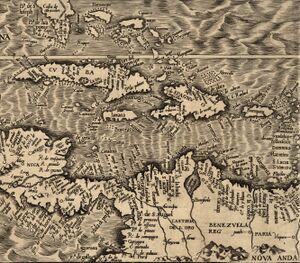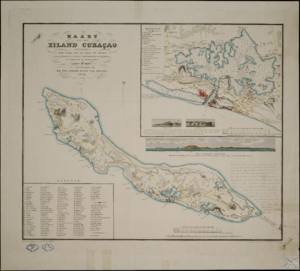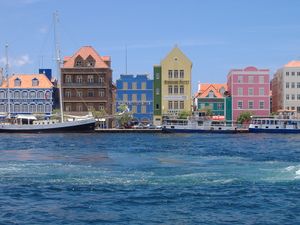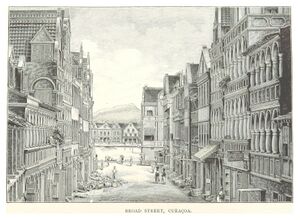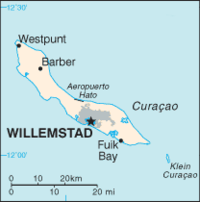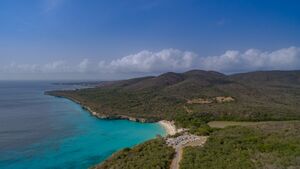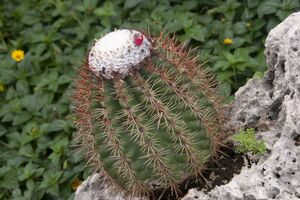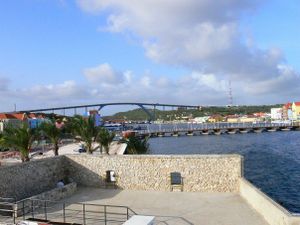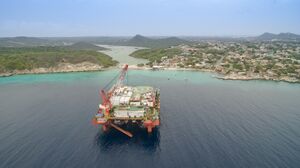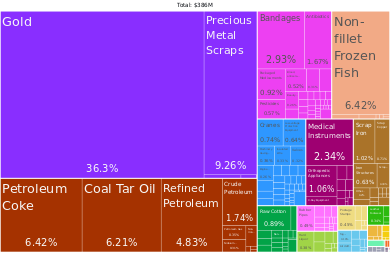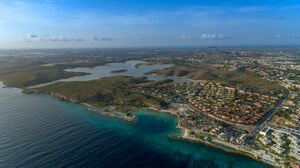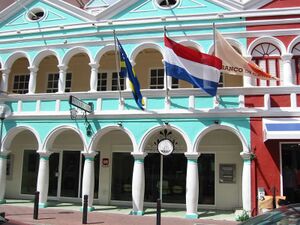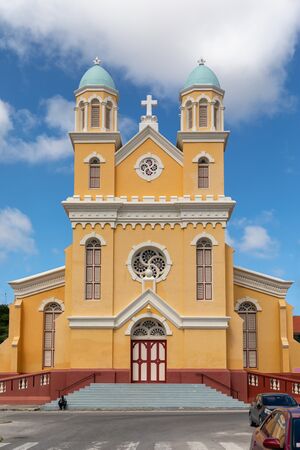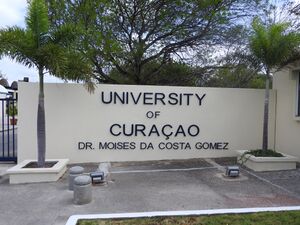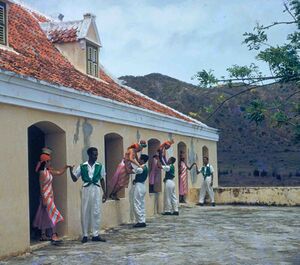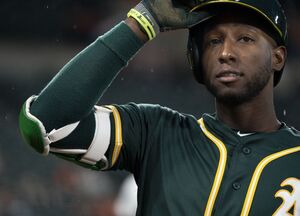كوراساو
كوراساو Eilandgebied Curaçao Teritorio Insular di Kòrsou | |
|---|---|
| Country of Curaçao Land Curaçao (هولندية) Pais Kòrsou (Papiamento) | |
| Anthem: "Himno di Kòrsou" (إنگليزية: "Anthem of Curaçao") | |
| Royal anthem: "Wilhelmus" (إنگليزية: "William of Nassau") | |
 Location of Curaçao (circled in red) | |
| Sovereign state | |
| Before separation | Netherlands Antilles |
| Country status | 10 October 2010 |
| العاصمة and largest city | ويلمستاد 12°7′N 68°56′W / 12.117°N 68.933°W |
| اللغات الرسمية | |
| الجماعات العرقية (2018) | 75.4% Afro-Curaçaoans/Mixed 9% Dutch 3.6% Dominican 3% Colombian 1.2% Haitian 1.2% Surinamese 1.1% Venezuelan 1.1% Aruban 0.9% unspecified 6% other[2] |
| الدين |
|
| صفة المواطن | Curaçaoan |
| الحكومة | Parliamentary representative democracy within a constitutional monarchy |
• Monarch | Willem-Alexander |
• Governor | Lucille George-Wout |
• Speaker | Charetti America-Francisca |
| Gilmar Pisas | |
| Legislature | Parliament of Curaçao |
| المساحة | |
• Total | 444[3] km2 (171 sq mi) |
| أعلى منسوب | 372 m (1٬220 ft) |
| التعداد | |
• 2023 estimate | 148,925[4] (177th) |
• Density | 349.13/km2 (904.2/sq mi) |
| GDP (PPP) | 2021[5] estimate |
• Total | $5.5 billion (184th) |
• Per capita | $35,484 (45th) |
| GDP (nominal) | 2021 estimate |
• Total | $3.5 billion[6] (149th) |
• Per capita | $22,581 (40th) |
| HDI (2012) | 0.811[7] very high |
| العملة | Netherlands Antillean guilder (ƒ) (ANG) |
| Time zone | UTC−4:00 (AST) |
| Mains electricity | 127 V–50 Hz |
| Driving side | right |
| Calling code | +599 |
| ISO 3166 code | |
| Internet TLD | .cw |
كوراساو Curaçao أكبر جزيرة في سلسلة جزر الأنتيل الهولندية. وهي تتكون من مجموعتين من الجزر تابعة لهولندا في جزر الهند الغربية.
تغطي جزيرة كوراساو مساحة قدرها 444 كم²، ويبلغ عدد سكانها نحو 150,000 نسمة، أما ويلمستاد أكبر مدن الجزيرة فهي عاصمة جزر الأنتيل الهولندية. كوراساو جزيرة ذات طبيعة جافة وأرض منبسطة، ومناخ دافئ طوال العام، وشواطئ جميلة أخاذة، ومدائن ساحرة. وتجذب هذه المميزات الكثير من السياح للجزيرة. غالبية سكان الجزيرة من السود أو ينحدرون من أصول سوداء وبيضاء مختلطة. تعيش فيها جالية عربية معظمها من المهاجرين اللبنانيين والسوريين.
وهناك مصاف لتكرير النفط الذي يجلب من فنزويلا المجاورة. تشمل النشاطات الاقتصادية الرئيسية في الجزيرة تكرير النفط والسياحة والتجارة. تقع هذه الجزيرة خارج حزام الأعاصير، لكن هذا لم يمنع من تعضرها لآثارٍ من إعصار فليكس.
Curaçao was formerly part of the Curaçao and Dependencies colony from 1815 to 1954 and later the Netherlands Antilles from 1954 to 2010, as Island Territory of Curaçao (هولندية: Eilandgebied Curaçao, قالب:Lang-pap),[8] and is now formally called the Country of Curaçao.[9] It includes the main island of Curaçao and the much smaller, uninhabited island of Klein Curaçao ("Little Curaçao").[9] Curaçao has a population of 158,665 (January 2019 est.),[3] with an area of 444 km2 (171 sq mi); its capital is Willemstad.[9]
. . . . . . . . . . . . . . . . . . . . . . . . . . . . . . . . . . . . . . . . . . . . . . . . . . . . . . . . . . . . . . . . . . . . . . . . . . . . . . . . . . . . . . . . . . . . . . . . . . . . . . . . . . . . . . . . . . . . . . . . . . . . . . . . . . . . . . . . . . . . . . . . . . . . . . . . . . . . . . . . . . . . . . . .
أصل الاسم
One explanation for the island's name is that Curaçao was the autonym by which its indigenous peoples identified themselves.[10] Early Spanish accounts support this theory, referring to the indigenous peoples as Indios Curaçaos.[11]
From 1525, the island was featured on Spanish maps as Curaçote, Curasaote, Curasaore, and even Curacaute.[12] By the 17th century, it appeared on most maps as Curaçao or Curazao.[11] On a map created by Hieronymus Cock in 1562 in Antwerp, the island was called Qúracao.[13]
A persistent but undocumented story claims the following: in the 16th and 17th centuries—the early years of European exploration—when sailors on long voyages got scurvy from lack of vitamin C, sick Portuguese or Spanish sailors were left on the island now known as Curaçao. When their ship returned, some had recovered, probably after eating vitamin C-rich fruit there. From then on, the Portuguese allegedly referred to the island as Ilha da Curação (Island of Healing) or the Spanish as Isla de la Curación.[9]
التاريخ
قبل الاستعمار
The original inhabitants of Curaçao were the Arawak and Caquetio Amerindians.[14] Their ancestors had migrated to the island from the mainland of South America, probably hundreds of years before Europeans first arrived.
الاستعمار الإسپاني
The first Europeans recorded as seeing the island were members of a Spanish expedition under the leadership of Alonso de Ojeda in 1499.[14] The Spaniards enslaved most of the Caquetios(Arawak) for forced labour in their Hispaniola colony, but paid little attention to the island itself.[14] In 1515, almost all of the 2,000 Caquetios living there were also transported to Hispaniola as slaves.
Starting in 1499, Curaçao served as a bridge for the Spanish exploration and conquest of territories in northern South America. The Spanish settled on the island in 1527. Throughout the 16th century, they ruled Curaçao as an insular part of the province of Venezuela, governing it from the mainland before gradually abandoning it as colonization of the continent progressed. One of the oldest written references to the island is in the archives of the main public city registry of Caracas, Venezuela. A document dated 9 December 1595 states that Francisco Montesinos, priest and vicar of "the Yslas de Curasao, Aruba and Bonaire" conferred his power of attorney to Pedro Gutiérrez de Lugo, a Caracas resident, to collect his ecclesiastic salary from the Royal Treasury of King Philip II of Spain.
The Spanish introduced numerous tree, plant and animal species to Curaçao, including horses, sheep, goats, pigs and cattle from Europe and other Spanish colonies. In general, imported sheep, goats and cattle did relatively well. Cattle were herded by Caquetios and Spaniards and roamed freely in the kunuku plantations and savannas.
Not all imported species fared equally well, and the Spanish also learned to use Caquetio crops and agricultural methods, as well as those from other Caribbean islands. Though historical sources point to thousands of people living on the island, agricultural yields were disappointing; this and the lack of precious metals in the salt mines led the Spanish to call Curaçao "the useless island".
Over time, the number of Spaniards living on Curaçao decreased while the number of aboriginal inhabitants stabilized. Presumably through natural growth, return and colonization, the Caquetio population then began to increase. In the last decades of Spanish occupation, Curaçao was used as a large cattle ranch. At that point, Spaniards lived around Santa Barbara, Santa Ana and in the villages in the western part of the island, while the Caquetios are thought to have lived scattered all over the island.
الاستعمار الهولندي
In 1634, during the Eighty Years' War of independence between the Republic of the Netherlands and Spain, the Dutch West India Company under Admiral Johann van Walbeeck invaded the island; the Spanish surrendered in San Juan in August. Approximately 30 Spaniards and many indigenous people were then deported to Santa Ana de Coro in Venezuela. About 30 Taíno families were allowed to live on the island while Dutch colonists started settling there.[14]
The Dutch West India Company founded the capital of Willemstad on the banks of an inlet called the Schottegat; the natural harbour proved an ideal place for trade. Commerce and shipping—and piracy—became Curaçao's most important economic activities. Later, salt mining became a major industry, the mineral being a lucrative export at the time.[بحاجة لمصدر] From 1662, the Dutch West India Company made Curaçao a centre of the Atlantic slave trade, often bringing slaves from West Africa to the island, before selling them elsewhere in the Caribbean and Spanish Main.[14]
Sephardic Jews fleeing persecution in Spain and Portugal sought safe haven in Dutch Brazil and the Dutch Republic. Many settled in Curaçao, where they made significant contributions to its civil society, cultural development and economic prosperity.[15]
In the Franco-Dutch War of 1672–78, French Count Jean II d'Estrées planned to attack Curaçao. His fleet—12 men-of-war, three fire ships, two transports, a hospital ship, and 12 privateers—met with disaster, losing seven men-of-war and two other ships when they struck reefs off the Las Aves archipelago. The serious navigational error occurred on 11 May 1678, a week after the fleet set sail from Saint Kitts. To commemorate its narrow escape from invasion, Curaçao marked the events with a day of thanksgiving, which was celebrated for decades into the 18th century.[بحاجة لمصدر]
Many Dutch colonists grew affluent from the slave trade, building impressive colonial buildings in the capital of Willemstad; the city is now a UNESCO World Heritage Site.
In 1795, a major slave revolt took place under the leaders Tula Rigaud, Louis Mercier, Bastian Karpata, and Pedro Wakao. Up to 4,000 slaves in northwest Curaçao revolted, with more than 1,000 taking part in extended gunfights. After a month, the slave owners were able to suppress the revolt.[16][17]
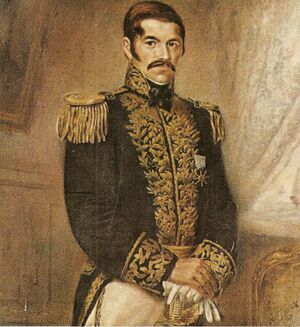
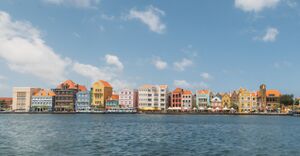
Curaçao's proximity to South America resulted in interaction with cultures of the coastal areas more than a century after the independence of the Netherlands from Spain. Architectural similarities can be seen between 19th century Willemstad neighborhoods and the nearby Venezuelan city of Coro in Falcón State, which has also been designated a World Heritage Site. Netherlands established economic ties with the Viceroyalty of New Granada that included the present-day countries of Colombia and Venezuela. In the 19th century, Curaçaoans such as Manuel Piar and Luis Brión were prominently engaged in the wars of independence of both Venezuela and Colombia. Political refugees from the mainland, such as Simon Bolivar, regrouped in Curaçao.[18]
During the 18th and 19th centuries, the British attacked the island several times, most notably in 1800, 1804, and from 1807 to 1815.[19] Stable Dutch rule returned in 1815 at the end of the Napoleonic wars, when the island was incorporated into the colony of Curaçao and Dependencies.[20]
The Dutch abolished slavery in 1863, causing vast changes in the economy with the shift to wage labour.[20] Some Curaçao inhabitants emigrated to other islands, such as Cuba, to work in sugarcane plantations. Other former slaves had nowhere to go and continued working for plantation owners under the tenant farmer system,[21] in which former slaves leased land from former masters, paying most of their harvest to owners as rent. The system lasted until the early 20th century.[بحاجة لمصدر]
Historically, Dutch was not widely spoken on the island outside of the colonial administration, but its use increased in the late 19th and early 20th centuries.[22] Students on Curaçao, Aruba, and Bonaire were taught predominantly in Spanish until the late 17th century, when the British took all three islands. Teaching of Spanish was restored when Dutch rule resumed in 1815. Also, efforts were made to introduce widespread bilingual Dutch and Papiamentu education in the late 19th century.[23]
القرنان 20 و 21
. . . . . . . . . . . . . . . . . . . . . . . . . . . . . . . . . . . . . . . . . . . . . . . . . . . . . . . . . . . . . . . . . . . . . . . . . . . . . . . . . . . . . . . . . . . . . . . . . . . . . . . . . . . . . . . . . . . . . . . . . . . . . . . . . . . . . . . . . . . . . . . . . . . . . . . . . . . . . . . . . . . . . . . .
بعد فض الأنتيل الهولندية
جغرافيا
Curaçao, as well as the rest of the ABC islands and Trinidad and Tobago, lies on the continental shelf of South America. It is a thin island with a generally hilly topography; the highest point is Christoffelberg in the northwest, with a peak at 372 m (1,220 ft) above sea level.[24] The coastline's bays, inlets and hot springs offer a source of natural minerals, thermal conditions, and seawater used in hydrotherapy and mesotherapy, making the island one of many balneoclimateric areas in the region. Off the southeast coast lies the small, flat island of Klein Curaçao.[9]
النبيت
Curaçao's flora differ from typical tropical island vegetation. Guajira-Barranquilla xeric scrub is the most notable, with various forms of cacti, thorny shrubs, evergreen, and watapana trees (Libidibia coriaria; called divi-divi on Aruba), which are characteristic of the ABC islands and the national symbol of Aruba. Brassavola nodosa is a drought-tolerant species of Brassavola, one of the few orchids present in the ABC islands. Cacti include Melocactus and Opuntia species such as Opuntia stricta.
الوحيش
Curaçao is semi-arid, and as such has not supported the numerous tropical species of mammals, birds, and lizards most associated with rainforests. Dozens of species of hummingbirds, bananaquits, orioles, and the larger terns, herons, egrets, and even flamingos make their homes near ponds or in coastal areas. The trupial, a black bird with a bright orange underbelly and white swatches on its wings, is common to Curaçao. The mockingbird, called chuchubi in Papiamentu, resembles the North American mockingbird, with a long white-grey tail and a grey back. Near shorelines, big-billed brown pelicans feed on fish. Other seabirds include several types of gulls and large cormorants.
Other than field mice, small rabbits, and cave bats, Curaçao's most notable animal is the white-tailed deer. This deer is related to the American white-tailed deer, or Virginia deer, found in areas from North America through Central America and the Caribbean, and as far south as Bolivia. It can be a large deer, some reaching six feet (2 m) in length and three feet (0.9 m) in height, and weighing as much as 300 pounds (140 kg). It has a long tail with a white underside, and is the only type of deer on the island. It has been a protected species since 1926, and an estimated 200 live on Curaçao. They are found in many parts of the island, but most notably at the west end's Christoffel Park, where about 70% of the herd resides. Archaeologists believe the deer were brought from South America to Curaçao by its original inhabitants, the Arawaks.[بحاجة لمصدر]
There are several species of iguana, light green in colour with shimmering shades of aqua along the belly and sides, found lounging in the sun across the island. The iguanas found on Curaçao serve not only as a scenic attraction but, unlike many islands that gave up the practice years ago, remain hunted for food. Along the west end of the island's north shore are several inlets that have become home to breeding sea turtles. These turtles are protected by the park system in Shete Boka Park, and can be visited accompanied by park rangers.[بحاجة لمصدر]
الطقس
| متوسطات الطقس لكوراساو، الأنتيل الهولندية | |||||||||||||
|---|---|---|---|---|---|---|---|---|---|---|---|---|---|
| شهر | يناير | فبراير | مارس | أبريل | مايو | يونيو | يوليو | أغسطس | سبتمبر | اكتوبر | نوفمبر | ديسمبر | السنة |
| العظمى القياسية °F (°C) | 91 (32.8) | 92 (33.2) | 91 (33.0) | 94 (34.7) | 96 (35.8) | 100 (37.5) | 95 (35.0) | 99 (37.4) | 101 (38.3) | 97 (36.0) | 96 (35.6) | 92 (33.3) | 101 (38٫3) |
| متوسط العظمى °ف (°م) | 85 (29.7) | 86 (30.0) | 87 (30.5) | 88 (31.1) | 89 (31.6) | 90 (32.0) | 89 (31.9) | 90 (32.4) | 91 (32.6) | 89 (31.9) | 88 (31.1) | 86 (30.1) | 88 (31٫2) |
| متوسط الصغرى °ف (°م) | 76 (24.3) | 76 (24.4) | 77 (24.8) | 78 (25.5) | 79 (26.3) | 80 (26.4) | 79 (26.1) | 79 (26.3) | 80 (26.5) | 79 (26.2) | 78 (25.6) | 77 (24.8) | 78 (25٫6) |
| الصغرى القياسية °ف (°C) | 69 (20.3) | 69 (20.6) | 70 (21.0) | 72 (22.0) | 71 (21.6) | 73 (22.6) | 72 (22.4) | 70 (21.3) | 71 (21.7) | 71 (21.9) | 72 (22.2) | 70 (21.1) | 69 (20٫3) |
| هطول الأمطار بوصة (mm) | 1.8 (44.7) | 1 (25.5) | 0.6 (14.2) | 0.8 (19.6) | 0.8 (19.6) | 0.8 (19.3) | 1.6 (40.2) | 1.6 (41.5) | 1.9 (48.6) | 3.3 (83.7) | 3.8 (96.7) | 3.9 (99.8) | 21٫8 (553٫4) |
| المصدر: [25] September 2008 | |||||||||||||
. . . . . . . . . . . . . . . . . . . . . . . . . . . . . . . . . . . . . . . . . . . . . . . . . . . . . . . . . . . . . . . . . . . . . . . . . . . . . . . . . . . . . . . . . . . . . . . . . . . . . . . . . . . . . . . . . . . . . . . . . . . . . . . . . . . . . . . . . . . . . . . . . . . . . . . . . . . . . . . . . . . . . . . .
الجيولوجيا
The northern seabed drops steeply within 60 m (200 ft) of the Curaçaoan shore. This drop-off is known as the "blue edge".
On Curaçao, four major geological formations can be found: the lava formation, the Knip formation, the Mid-Curaçao formation and limestone formations.[26]
Curaçao lies within the Caribbean large igneous province (CLIP) with key exposures of those lavas existing on the island consisting of the Curaçao Lava Formation (CLF). The CLF consists of 5 km of pillow lavas with some basalt intrusions. The ages of these rocks include 89 Ma for the lavas and 75 Ma for the poikilitic sills, though some sequences may have erupted as late as 62–66 Ma, placing them in the Cretaceous period. Their composition includes picrite pillows at the base, followed by tholeiitic lavas, then hyaloclastites, then the poikilitic sills. The CLF was gradually uplifted until Eocene-Miocene limestone caps formed, before final exposure above sea level. Christoffelberg and the Zevenbergen (Seven Hills) portion of the island have exposures of the Knip Formation. This formation includes deepwater deposits of calcareous sands and fine clays, capped by siliceous chert containing radiolarians. Middle Curaçao contains alluvial soils from eroded CLF and limestone.[27][28]
سياسة كوراساو
الاقتصاد
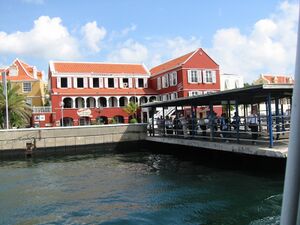
Curaçao has an open economy; its most important sectors are tourism, international trade, shipping services, oil refining,[29] oil storage and bunkering, and international financial services.[9] Venezuelan state oil company PDVSA's lease on the island's oil refinery expired in 2019; the facility employs 1,000 people, refining oil from Venezuela for export to the US and Asia.[30] Schlumberger, the world's largest oil field services company, is incorporated in Curaçao.[31] The Isla oil refinery is said to be responsible for Curaçao's position as one of the world's top five highest per capita CO2 emission-producing countries.[32]
Along with Sint Maarten, Curaçao uses the Netherlands Antillean guilder as its currency.[9] Its economy is well-developed, supporting a high standard of living, ranking 46th in the world in terms of GDP (PPP) per capita and 27th in the world in terms of nominal GDP per capita. Curaçao possesses a high-income economy as defined by the World Bank.[33][34] Activities related to the port of Willemstad, such as the Free Trade Zone, make significant contributions to the economy.[9] To achieve greater economic diversification, the Curaçaoan government is increasing its efforts to attract more foreign investment.[9] This policy, called the "Open Arms" policy, features a heavy focus on attracting information technology companies.[35][36][37]
Since 2016, reduced foreign demand for goods due to the ongoing unrest and political uncertainty in Venezuela has led to decreased exports and increased domestic demand for goods and services, resulting in economic stagnation. While many economic sectors contracted, expansion took place in the construction, financial intermediation, and utilities sectors.[38]
السياحة
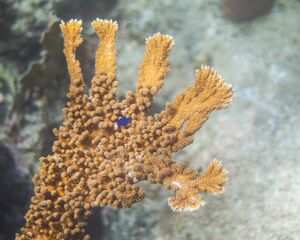
While tourism plays a major role in Curaçao's economy, the island is less reliant on tourism than many other Caribbean countries. Most tourists come to Curaçao from the Netherlands, the eastern United States, South America and other Caribbean islands.[بحاجة لمصدر] Curaçao was a Caribbean leader in cruise ship tourism growth, with 610,186 cruise passengers in 2013, a 41.4% increase over the previous year.[39] Hato International Airport received 1,772,501 passengers in 2013 and announced capital investments totaling US$48 million aimed at transforming the airport into a regional hub by 2018.
The Curaçaoan insular shelf's sharp drop-off known as the "Blue Edge" is often visited by scuba diving tourists.[40] Coral reefs for snorkeling and scuba diving can be reached without a boat. The southern coast has calm waters as well as many small beaches, such as Jan Thiel and Cas Abou. At the westernmost point of the island is Watamula and the Cliff Villa Peninsula which are good locations for drift diving. The coastline of Curaçao features numerous bays and inlets which serve as popular mooring locations for boats.[41]
In June 2017, the island was named the Top Cruise Destination in the Southern Caribbean by Cruise Critic, a major online forum. The winners of the Destination Awards were selected based on comments from cruise passengers who rated the downtown area of Willemstad as "amazing" and the food and shopping as "excellent".[42] The historic centre of Willemstad is a World Heritage Site. Another attraction is the towns colourful street art. the Blue Bay Sculpture Garden with works from known Curaçao artists is situated in a nearby resort.[43] Landhuis Bloemhof is an art museum and gallery located in Willemstad.[44]
Some of the coral reefs are affected by tourism. Porto Marie Beach is experimenting with artificial coral reefs in order to improve the reef's condition.[بحاجة لمصدر] Hundreds of artificial coral blocks that have been placed are now home to a large array of tropical fish. It is now under investigation to see if the sewer waste of hotels is a partial cause of the dying of the coral reef.[45]
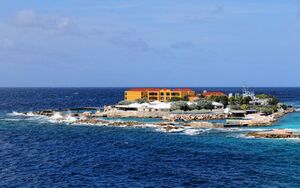
العمل
In 2016, a Labour Force Survey (LFS) indicated that the unemployment rate was 13.3%. For residents ages 15–64, the employment rate was 70.4%.[46][47]
الخدمات المالية
Curaçao's history in financial services dates back to World War I. Prior to this period, the financial arms of local merchant houses functioned as informal lenders to the community. However, at the turn of the 20th century, Curaçao underwent industrialization, and a number of merchant houses established private commercial banks.[48] As the economy grew, these banks began assuming additional functions eventually becoming full-fledged financial institutions.
The Dutch Caribbean Securities Exchange is located in the capital of Willemstad, as is the Central Bank of Curaçao and Sint Maarten; the latter of which dates to 1828. It is the oldest central bank in the Western Hemisphere.[49] The island's legal system supports a variety of corporate structures and is a corporate haven. Though Curaçao is considered a tax haven, it adheres to the EU Code of Conduct against harmful tax practices. It holds a qualified intermediary status from the United States Internal Revenue Service. It is an accepted jurisdiction of the OECD and Caribbean Financial Action Task Force on Money Laundering. The country enforces Anti-Money Laundering and Counter-Terrorism funding compliance.[بحاجة لمصدر]
Foreign Account Tax Compliance Act
On 30 June 2014, Curaçao[50] was deemed to have an Inter-Governmental Agreement (IGA) with the United States of America with respect to the "Foreign Account Tax Compliance Act" of the United States of America. The Tax Information Exchange Agreement signed in Washington, D.C. on 17 April 2002[51] between the U.S. and the Kingdom of the Netherlands includes Curaçao, and was updated with respect to Curaçao in 2014, taking effect in 2016.
التجارة
Curaçao trades mainly with the United States, Venezuela, and the European Union. It has an Association Agreement with the European Union which allows companies which do business in and via Curaçao to export products to European markets,[52] free of import duties and quotas. It is also a participant in the US Caribbean Basin Initiative allowing it to have preferential access to the US market.[53]
الدعارة
Prostitution in Curaçao is legal only for foreign women who get a temporary permit to work in the large open-air brothel called "Le Mirage" or "Campo Alegre". Using prostitution services is legal for men (locals included). The brothel has operated near the airport since the 1940s.[54][55] Curaçao monitors, contains and regulates the industry. The government states that the workers in these establishments are thereby given a safe environment and access to medical practitioners. However this approach does exclude local women (or men) to legally make a living from prostitution and does lead to loss of local income, as the foreign prostitutes send or take most of their earnings home.[56]
The U.S. State Department has cited anecdotal evidence claiming that, "Curaçao...[is a] destination island... for women trafficked for the sex trade from Peru, Brazil, Colombia, the Dominican Republic, and Haiti, according to local observers. At least 500 foreign women reportedly are in prostitution throughout the five islands of the Antilles, some of whom have been trafficked."[57] The US Department of State has said that the government of Curaçao frequently underestimates the extent of human trafficking problems.[57]
السكان

Owing to the island's history of colonial times, the majority of the Curaçaoans are of African, or partial African descent.[9] There are also many people of Dutch, French, Latin American, South Asian, East Asian, and Levantine descent.[بحاجة لمصدر]
الدين
- Religion in Curaçao[58]
The religious breakdown of the population of Curaçao, according to a 2011 estimate:[58]
- Roman Catholic;[58] 69.8%
- Adventist;[58] 9%
- Evangelical;[58] 8.9%
- Pentecostal;[58] 7.6%
- Other Protestant;[58] 3.2%
- Jehovah's Witnesses;[58] 2%
- Other;[58] 3.8%
- None;[58] 10%
- Unspecified;[58] 0.6%
There has been a shift towards the Charismatic movement in recent decades. Other denominations include the Seventh-day Adventist Church and the Methodist Church. Alongside these Christian denominations, some inhabitants practise Montamentu and other diaspora African religions.[59] As elsewhere in Latin America, Pentecostalism is on the rise.[بحاجة لمصدر] There are also practising Muslims and Hindus.
The Roman Catholic Diocese of Willemstad encompasses all the territory of the Kingdom of the Netherlands in the Caribbean which includes Aruba, Curaçao, Sint Maarten, and the islands of Bonaire, St. Eustatius and Saba. The diocese is also a member of the Antilles Episcopal Conference.[بحاجة لمصدر]
While small, Curaçao's Jewish community has had a significant impact on the island's history.[15] Curaçao has the oldest active Jewish congregation in the Americas, dating to 1651. The Curaçao synagogue is the oldest synagogue of the Americas in continuous use, since its completion in 1732 on the site of a previous synagogue.[60] Additionally, there are both Sephardic and Ashkenazi Jewish communities.[9] As of the year 2000 there were approximately 300 Jewish people living on the island.[61]
اللغات
Curaçao is a polyglot society. The official languages are Dutch, Papiamentu and English.[1][9] However, Dutch is the sole language for all administration and legal matters.[62] Most of Curaçao's population is able to converse in at least two of the languages of Papiamentu, Dutch, English, and Spanish.[بحاجة لمصدر]
The most widely spoken language is Papiamentu, a Portuguese creole with African, Dutch and Spanish influences, spoken in all levels of society.[9] Papiamentu was introduced as a language of primary school education in 1993, making Curaçao one of a handful of places where a creole language is used as a medium to acquire basic literacy.[63] Spanish and English also have a long historical presence in Curaçao. Spanish became an important language in the 18th century due to the close economic ties with Spanish territories in what are now Venezuela and Colombia[22] and several Venezuelan TV networks are received. Use of English dates to the early 19th century, when the British took Curaçao, Aruba and Bonaire. When Dutch rule resumed in 1815, officials already noted wide use of the language.[22]
According to the 2001 census, Papiamentu was the first language of 81.2% of the population. Dutch of 8%, Spanish of 4%, and English of 2.9%.[64] However, these numbers divide the population in terms of first language and do not account for the high rate of bilingualism in the population of Curaçao.[بحاجة لمصدر]
الأماكن
Curaçao was divided into five districts from 1863 to 1925, after which it was reduced to the two outer districts of Bandabou and Bandariba and the city district of Willemstad. Over the years, the capital, Willemstad, encompassed the entire area surrounding the large natural harbour, the Schottegat. As a result, many formerly isolated villages have grown together to form a large urbanised area. The city covers approximately one third of the entire island in the east. Willemstad's most famous neighbourhoods are:
- Punda, the historic city centre with the Handelskade on St. Anna Bay.
- Otrobanda, on the other side of St. Anna Bay
- Pietermaai, east of Punda
- Scharloo, north of Punda and Pietermaai, across the Waaigat
- Julianadorp, a suburb on the west side of the city, built around 1928 on behalf of Shell for its personnel
- Emmastad, built for Shell in the 1950s, after Julianadorp was full.
- Saliña is situated next to Punda and has many shops and restaurants.
- Brievengat, a suburb in the north of the city.
بنية السكان
| Age Group | Male | Female | Total | % |
|---|---|---|---|---|
| Total | 69 285 | 83 084 | 152 369 | 100 |
| 0–4 | 3 876 | 3 637 | 7 513 | 4.93 |
| 5–9 | 4 750 | 4 479 | 9 229 | 6.06 |
| 10–14 | 4 487 | 4 401 | 8 888 | 5.83 |
| 15–19 | 4 503 | 4 393 | 8 895 | 5.84 |
| 20–24 | 3 891 | 3 665 | 7 556 | 4.96 |
| 25–29 | 3 862 | 4 280 | 8 142 | 5.34 |
| 30–34 | 3 966 | 4 774 | 8 740 | 5.74 |
| 35–39 | 4 081 | 5 091 | 9 172 | 6.02 |
| 40–44 | 3 833 | 5 099 | 8 932 | 5.86 |
| 45–49 | 4 563 | 5 790 | 10 353 | 6.79 |
| 50–54 | 5 049 | 6 323 | 11 372 | 7.46 |
| 55–59 | 5 481 | 7 013 | 12 493 | 8.20 |
| 60–64 | 4 937 | 6 576 | 11 513 | 7.56 |
| 65-69 | 4 098 | 5 523 | 9 621 | 6.31 |
| 70-74 | 3 427 | 4 506 | 7 932 | 5.21 |
| 75-79 | 2 163 | 3 342 | 5 504 | 3.61 |
| 80-84 | 1 346 | 2 146 | 3 492 | 2.29 |
| 85-89 | 661 | 1 283 | 1 944 | 1.28 |
| 90-94 | 248 | 543 | 791 | 0.52 |
| 95-99 | 59 | 192 | 250 | 0.16 |
| 100+ | 8 | 35 | 43 | 0.03 |
| Age group | Male | Female | Total | Percent |
| 0–14 | 13 113 | 12 517 | 25 630 | 16.82 |
| 15–64 | 44 162 | 52 997 | 97 159 | 63.77 |
| 65+ | 12 010 | 17 570 | 29 580 | 19.41 |
إخصائيات
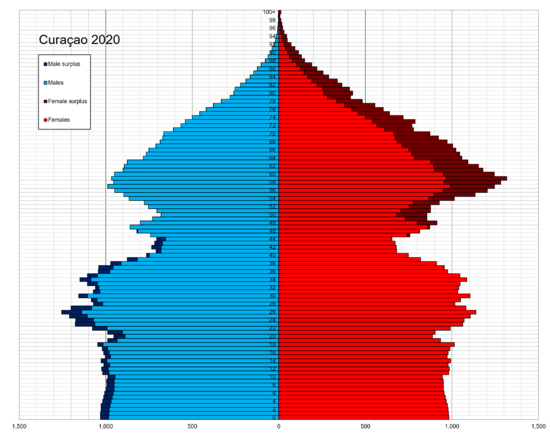
التعليم
Public education is based on the Dutch educational system and besides the public schools, private and parochial schools are also available. Since the introduction of a new public education law in 1992, compulsory primary education starts at age six and continues for six years; secondary lasts for another four.[66]
The main institute of higher learning is the University of Curaçao (formerly University of The Netherlands Antilles), enrolling 2,100 students.[66] The comprehensive model of education is influenced by both the Dutch and American education systems. Other higher education offerings on the island include offshore medical schools, language schools and academies for fine art, music, police, teacher and nurse-training.[67]
الثقافة
الأدب
Despite the island's relatively small population, the diversity of languages and cultural influences on Curaçao have generated a remarkable literary tradition, primarily in Dutch and Papiamentu. The oral traditions of the Arawak indigenous peoples are lost. West African slaves brought the tales of Anansi, thus forming the basis of Papiamentu literature. The first published work in Papiamentu was a poem by Joseph Sickman Corsen entitled Atardi, published in the La Cruz newspaper in 1905.[بحاجة لمصدر] Throughout Curaçaoan literature, narrative techniques and metaphors best characterized as magic realism tend to predominate. Novelists and poets from Curaçao have contributed to Caribbean and Dutch literature. Best known are Cola Debrot, Frank Martinus Arion, Pierre Lauffer, nl (Elis Juliana), Guillermo Rosario, nl (Boeli van Leeuwen) and Tip Marugg.[بحاجة لمصدر]
Cuisine
Local food is called Krioyo (pronounced the same as criollo, the Spanish word for "Creole") and boasts a blend of flavours and techniques best compared to Caribbean cuisine and Latin American cuisine. Dishes common in Curaçao are found in Aruba and Bonaire as well. Popular dishes include stobá (a stew made with various ingredients such as papaya, beef or goat), Guiambo (soup made from okra and seafood), kadushi (cactus soup), sopi mondongo (intestine soup), funchi (cornmeal paste similar to fufu, ugali and polenta) and fish and other seafood. The ubiquitous side dish is fried plantain. Local bread rolls are made according to a Portuguese recipe. All around the island, there are snèks which serve local dishes as well as alcoholic drinks in a manner akin to the English public house.[بحاجة لمصدر]
The ubiquitous breakfast dish is pastechi: fried pastry with fillings of cheese, tuna, ham, or ground meat. Around the holiday season special dishes are consumed, such as the hallaca and pekelé, made out of salt cod. At weddings and other special occasions a variety of kos dushi are served: kokada (coconut sweets), ko'i lechi (condensed milk and sugar sweet) and tentalaria (peanut sweets). The Curaçao liqueur was developed here, when a local experimented with the rinds of the local citrus fruit known as laraha. Surinamese, Chinese, Indonesian, Indian and Dutch culinary influences also abound. The island also has a number of Chinese restaurants that serve mainly Indonesian dishes such as satay, nasi goreng and lumpia (which are all Indonesian names for the dishes). Dutch specialties such as croquettes and oliebollen are widely served in homes and restaurants.[بحاجة لمصدر]
الرياضة
In 2004, the Little League Baseball team from Willemstad, Curaçao, won the world title in a game against the United States champion from Thousand Oaks, California. The Willemstad lineup included Jurickson Profar, the standout shortstop prospect who now plays for the San Diego Padres of Major League Baseball, and Jonathan Schoop.[68]
Curaçaoan players Andruw Jones,[69] Ozzie Albies, and Kenley Jansen have made multiple Major League Baseball All-Star Game appearances.[70]
The 2010 documentary film Boys of Summer[71] details Curaçao's Pabao Little League All-Stars winning their country's eighth straight championship at the 2008 Little League World Series, then going on to defeat other teams, including Puerto Rico and the Dominican Republic, and earning a spot in Williamsport.[72]
The prevailing trade winds and warm water make Curaçao a location for windsurfing.[73][74]
There is warm, clear water around the island. Scuba divers and snorkelers may have visibility up to 30 metres (98 feet) at the Curaçao Underwater Marine Park, which stretches along 20 kilometres (12 miles) of Curaçao's southern coastline.[75]
Curaçao participated in the 2013 CARIFTA Games. Kevin Philbert stood third in the under-20 male Long Jump with a distance of 7.36 metres (24.15 feet). Vanessa Philbert stood second the under-17 female 1,500 metres (4,900 feet) with a time of 4:47.97.[76][77][78][79]
The Curaçao national football team won the 2017 Caribbean Cup by defeating Jamaica in the final, qualifying for the 2017 CONCACAF Gold Cup.[80] They then traveled to Thailand and participated in the 2019 King's Cup for the first time, eventually winning the tournament by beating Vietnam in the final.[81]
انظر أيضاً
المصادر
- Habitantenan di Kòrsou, sinku siglo di pena i gloria: 1499–1999. Römer-Kenepa, NC, Gibbes, FE, Skriwanek, MA. , 1999. Curaçao: Fundashon Curaçao 500.
- Social movements, violence, and change: the May Movement in Curaçao. WA Anderson, RR Dynes, 1975. Columbus: Ohio State University Press.
- Stemmen uit het Verleden. Van Buurt, G., Joubert, S., 1994, Curaçao.
- Het Patroon van de Oude Curaçaose Samenleving. Hoetink, H., 1987. Amsterdam: Emmering.
- Dede pikiña ku su bisiña: Papiamentu-Nederlands en de onverwerkt verleden tijd. van Putte, Florimon., 1999. Zutphen: de Walburg Pers
- Halman, Johannes and Robert Rojer (2008). Jan Gerard Palm Music Scores: Waltzes, Mazurkas, Danzas, Tumbas, Polkas, Marches, Fantasies, Serenades, a Galop and Music Composed for Services in the Synagogue and the Lodge. Amsterdam: Broekmans en Van Poppel.*[1]
- Halman, Johannes I.M. and Rojer, Robert A. (2008). Jan Gerard Palm: Life and Work of a Musical Patriarch in Curaçao (In Dutch language). Leiden: KITLV.
{{cite book}}: CS1 maint: multiple names: authors list (link)*[2] - Palm, Edgar (1978). Muziek en musici van de Nederlandse Antillen. Curaçao: E. Palm.
- Boskaljon, Rudolph (1958). Honderd jaar muziekleven op Curaçao. Anjerpublicaties 3. Assen: Uitg. in samenwerking met het Prins Bernhard fonds Nederlandse Antillen door Van Gorcum.
هامش
- ^ أ ب (in nl)Landsverordening van de 28ste maart 2007 houdende vaststelling van de officiële talen (Landsverordening officiële talen), https://lokaleregelgeving.overheid.nl/CVDR144328
- ^ "Curacao". The World Factbook. Central Intelligence Agency. Retrieved 29 December 2019.
- ^ أ ب "Waaruit bestaat het Koninkrijk der Nederlanden?". Rijksoverheid (in الهولندية). 19 May 2015.
- ^ "Population". Central Bureau of Statistics Curaçao. January 2023. Archived from the original on 2023-04-11. Retrieved 2023-06-10.
- ^ van der Molen, Maarten (19 September 2013). "Country Report Curaçao". RaboResearch - Economic Research. Retrieved 23 August 2017.
- ^ "Curacao". The World Bank. Retrieved 2021-08-09.
- ^ (in nl)Human Development Index (HDI): Korte Notitie inzake de berekening van de voorlopige Human Development Index (HDI) voor Curaçao, Centraal Bureau voor de Statistiek, 20 December 2013, http://www.cbs.cw/cbs/themes/Labour%20and%20Social%20Security/Data/Labour%20&%20Social%20Security-20140511112021.pdf, retrieved on 13 July 2015
- ^ English name is used by the Government of Curaçao and the Government of the Netherlands Antilles, as English was an official language of the Netherlands Antilles and the Island Territory of Curaçao.
- ^ أ ب ت ث ج ح خ د ذ ر ز س ش خطأ استشهاد: وسم
<ref>غير صحيح؛ لا نص تم توفيره للمراجع المسماةCIA World Factbook- Curaçao - ^ Joubert and Van Buurt, 1994
- ^ أ ب "Curaçao" Archived 24 فبراير 2021 at the Wayback Machine, Curaçao-nature.com, 2005–2016. Retrieved 12 August 2016
- ^ "Taino Names of the Caribbean Islands". 2 February 2015.
- ^ Cock's 1562 map, Library of Congress website
- ^ أ ب ت ث ج "The History of Curaçao". Retrieved 15 July 2019.
- ^ أ ب "Curacao Virtual Jewish History Tour". jewishvirtuallibrary.org.
- ^ "Curaçao History". Papiamentu.net. Retrieved 2010-10-10.
- ^ Rodriguez, Junius P. (2007). Encyclopedia of Slave Resistance and Rebellion (in الإنجليزية). Greenwood Publishing Group. ISBN 9780313332739.
- ^ "Octagon Museum – Curaçao Art".
- ^ "Curacao in the British Empire".
- ^ أ ب "The History of Curaçao". Retrieved 2019-07-15.
- ^ Called "Paga Tera"
- ^ أ ب ت Dede pikiña ku su bisiña: Papiamentu-Nederlands en de onverwerkt verleden tijd. van Putte, Florimon., 1999. Zutphen: de Walburg Pers
- ^ Van Putte 1999.
- ^ "The World Factbook – Central Intelligence Agency". cia.gov. Retrieved 28 November 2017.
- ^ "Climatological Summary for Curaçao". Meteorological service of Netherlands Antilles and Aruba.
- ^ "CARMABI Research Station Curaçao". researchstationcarmabi.org.
- ^ Loewen, M.W.; Duncan, R.A.; Krawl, K.; Kent, A.J.; Sinton, C.W.; Lackey, J. (2011). "Prolonged volcanic history for the Curaçao Lava Formation inferred from new 40Ar-39Ar ages and trace phase geochemistry". American Geophysical Union, Fall Meeting 2011, Abstract Id. V51D-2542. 2011: V51D–2542. Bibcode:2011AGUFM.V51D2542L.
- ^ van Buurt, Gerard (2010). "A Short Natural History of Curaçao. In: Crossing Shifting Boundaries, Language and Changing Political status in Aruba, Bonaire and Curaçao" (PDF). Proceedings of the ECICC-conference, Dominica 2009. I: 229–256. Archived from the original (PDF) on 19 May 2019. Retrieved 3 September 2018.
- ^ "Dutch Caribbean Refineries on Uncertain Path – Carib Flame". Caribflame.com. Retrieved 23 August 2017.
- ^ "Curacao Economy 2017, CIA World Factbook". Theodora.com. Retrieved 23 August 2017.
- ^ "Schlumberger N.V. – Company Information".
- ^ "COP21 alert: Caribbean part of Dutch Kingdom belongs to top 5 CO2 emissions per capita | Stichting SMOC". www.stichtingsmoc.nl (in الهولندية). Retrieved 2 January 2018.
- ^ The World Bank. "Excel file of historical classifications by income". Retrieved 18 March 2020.
- ^ "How are the income group thresholds determined? – World Bank Data Help Desk". datahelpdesk.worldbank.org. Retrieved 18 March 2020.
- ^ "An investor's guide to the welcoming island of Curaçao" (PDF). Retrieved 10 October 2010.
- ^ Mindmagnet.com (1 March 2001). "Ecommerce at Curaçao Corporate". Ecommerceatcuracao.com. Retrieved 23 May 2009.
- ^ "Economic Data Overview". Investcuracao.com. Archived from the original on 2009-02-28. Retrieved 23 May 2009.
- ^ "Economic Developments in 2016 and outlook for 2017 / Economische ontwikkelingen in 2016 en vooruitzichten voor 2017 – Curacao / Sint Maarten – BearingPoint Caribbean". Bearingpointcaribbean.com. 14 February 2017. Archived from the original on 2017-08-03. Retrieved 23 August 2017.
- ^ "Curaçao Leading Caribbean in Cruise Tourism Growth". Caribjournal.com. 14 February 2014. Retrieved 14 February 2014.
- ^ "An Underwater Photographer's Guide to Curaçao". DivePhotoGuide. Retrieved 23 August 2017.
- ^ "Curacao vakantie – Curacao vakantie". Curacao vakantie (in الهولندية). Retrieved 4 November 2016.
- ^ "Curaçao has been named the Top Cruise destination in the Southern Caribbean". Curacaochronicle.com. 27 July 2017. Retrieved 23 August 2017.
- ^ "Blue Bay Beeldentuin". Curacao Art. Retrieved 21 April 2021.
- ^ "Landhuis Bloemhof". Beautiful Curaçao. Retrieved 21 April 2021.
- ^ NTR, Omroep. "Vernietigt toeristenpoep ons Nederlandse koraal?". NPO Focus.
- ^ "Statistics: "Unemployment rate rose to 13.3 percent"". Curacaochronicle.com. 1 February 2017. Retrieved 23 August 2017.
- ^ "Supply Side of the Labour Market Curaçao: Labour Force Survey 2016 – BearingPoint Caribbean". Bearingpointcaribbean.com. 3 March 2017. Archived from the original on 2017-08-03. Retrieved 23 August 2017.
- ^ "Twentieth Century Private Banking – Roots of Our Future". caribseek.com. 11 December 2002. Archived from the original on 14 May 2003. Retrieved 14 February 2014.
- ^ "In 175 years the Bank has evolved from a near dormant institution in the nineteenth century to a vibrant organization able to adapt to the ever changing financial world in the twenty-first century". centralbank.an. 1 February 2003. Archived from the original on 12 December 2013. Retrieved 6 December 2013.
- ^ U.S. Treasury FACTA.
- ^ U.S. Treasury Agreement with Curaçao (pdf).
- ^ "EU Trade Program". archive.org. 24 June 2007. Archived from the original on 24 June 2007.
- ^ "USTR – Caribbean Basin Initiative". Ustr.gov. 1 October 2000. Archived from the original on 5 May 2009. Retrieved 23 May 2009.
- ^ "Sex Tourism And Trafficking In The Dutch Caribbean". Curacao Chronicle. 26 November 2012. Retrieved 23 December 2017.
- ^ "Curaçao Opens Campo Alegre Brothel". NSWP. Retrieved 24 December 2017.
- ^ "Curaçao's X-Rated Resort". Global Writes. 2009. Retrieved 3 October 2012.
- ^ أ ب "Trafficking in Persons Report". U.S. State Dept. 4 June 2008. p. 192.
- ^ أ ب ت ث ج ح خ د ذ ر ز "Central America and Caribbean: Curaçao". CIA The World Factbook. 19 October 2021.
- ^ Bernadina, Frieda (1981). Montamentoe: een beschrijvende en analyserende studie van een Afro-Amerikaanse godsdienst op Curaçao. Curaçao: Bernadina.
- ^ "Dwindling Community of Curacao Maintains Oldest Synagogue in West". Archived from the original on 2014-01-06.
- ^ "The Jewish Community of Curacao".
- ^ "About Us". DutchCaribbeanLegalPortal.com. Retrieved 20 May 2014.
- ^ Anthony Liddicoat (15 June 2007). Language planning and policy: issues in language planning and literacy. Multilingual Matters. p. 149. ISBN 978-1-85359-977-4. Retrieved 9 August 2011.
- ^ "Households by the most spoken language in the household Population and Housing Census 2001". Central Bureau of Statistics. Archived from the original on 2012-10-29.
- ^ "UNSD — Demographic and Social Statistics". unstats.un.org. Retrieved 2023-05-10.
- ^ أ ب Walton, R.H. (2006). Cold Case Homicides: Practical Investigative Techniques. CRC Press. p. 87. ISBN 978-1-4200-0394-9.
- ^ Rosalind Latiner, Raby (2009). Community College Models: Globalization and Higher Education Reform. Springer. p. 260. ISBN 978-1-4020-9477-4. Retrieved 7 May 2013.
- ^ "Curacao an island unto itself when it comes to producing big-league ballplayers". Los Angeles Times. Retrieved 18 April 2021.
- ^ "Atlanta Braves: It's time to retire Andruw Jones' number 25". calltothepen.com. 5 February 2022. Retrieved 7 February 2022.
- ^ "Jansen's 3-K ninth highlights LA's ASG". MLB. Retrieved 7 February 2022.
- ^ "Boys of Summer". Boysofsummerfilm.com. Retrieved 20 May 2014.
- ^ "Boys of Summer: Documentary Spotlights Youth Baseball in Cuaraçao". Large Up. 10 March 2014. Retrieved 18 April 2021.
- ^ "Curaçao's Caribbean sister islands, Aruba and Bonaire, are well known in the windsurfing world. Curaçao, which receives the same Caribbean trade winds as its siblings, has remained undiscovered by traveling windsurfers". Windsurfingcuracao.com. 7 August 2011. Retrieved 20 May 2014.
- ^ Motion Magazine, June 2005
- ^ "Frommers Guide to Curaçao water sports". The New York Times. 20 November 2006.
- ^ 42nd CARIFTA BAHAMAS in 2013 – 3/30/2013 to 4/1/2013 – T. A. ROBINSON NATIONAL TRACK & FIELD STADIUM – Nassau, Bahamas – Results, C.F.P.I. Timing & Data, http://www.cfpitiming.com/2013_Outdoor_Season/Carifta_Games_2013/Carifta_Games_male_results_2013.htm, retrieved on 13 November 2013
- ^ 42nd CARIFTA BAHAMAS in 2013 – 3/30/2013 to 4/1/2013 – T. A. ROBINSON NATIONAL TRACK & FIELD STADIUM – Nassau, Bahamas – Results, MileSplit, http://bah.milesplit.com/meets/130723/results/239214, retrieved on 13 November 2013
- ^ 42nd CARIFTA BAHAMAS in 2013 – 3/30/2013 to 4/1/2013 – T. A. ROBINSON NATIONAL TRACK & FIELD STADIUM – Nassau, Bahamas – Results, C.F.P.I. Timing & Data, http://www.cfpitiming.com/2013_Outdoor_Season/Carifta_Games_2013/Carifta_Games_female_results_2013.htm, retrieved on 13 November 2013
- ^ 42nd CARIFTA BAHAMAS in 2013 – 3/30/2013 to 4/1/2013 – T. A. ROBINSON NATIONAL TRACK & FIELD STADIUM – Nassau, Bahamas – Results, MileSplit, http://bah.milesplit.com/meets/130723/results/239213, retrieved on 13 November 2013
- ^ "Curaçao edges Jamaica for first-ever Caribbean Cup title". CONCACAF Gold Cup. 26 June 2017.
- ^ "Elson Hooi slept King's Cup in de wacht met Curaçao" [Elson Hooi wins King's Cup with Curaçao] (in الهولندية). ADO Den Haag. 8 June 2019. Retrieved 9 June 2019.
وصلات خارجية
| Curaçao
]].- [3] - CIA World Factbook page on Netherlands Antilles, of which Curaçao is a part
- Curacao-gov.an - official website of the government of Curaçao
- Rinkes Curaçao - Rinkes website about (the architecture of) Curaçao
- Curaçao is at coordinates 12°11′N 69°00′W / 12.183°N 69.000°WCoordinates: 12°11′N 69°00′W / 12.183°N 69.000°W
- كوراساو travel guide from Wikitravel
- Curacao-Photos.com - pictures of Curaçao sent in by various photographers
- noskorsou.com - Information of Curaçao Vakantie, Locaties.
- Hasibokos.com - Curaçao news and current events .
- CS1 الهولندية-language sources (nl)
- Short description is different from Wikidata
- Articles with hatnote templates targeting a nonexistent page
- Articles containing هولندية-language text
- Articles containing Papiamento-language text
- Articles containing إنگليزية-language text
- Pages using center with no arguments
- Articles with unsourced statements from July 2019
- Articles with unsourced statements from August 2019
- Articles with unsourced statements from January 2021
- Articles with unsourced statements from February 2020
- Articles with unsourced statements from September 2013
- Coordinates on Wikidata
- كوراساو
- مملكة هولندا
- جزر الأنتيل الهولندية
- بلدان كاريبية في مملكة هولندا
- بلدان جزر
- بلدان وأقاليم ناطقة بالهولندية
- بلدان وأقاليم حيث الإنجليزية هي لغة رسمية
- تأسيسات 1954 في الأنتيل الهولندية
- ولايات وأقاليم تأسست في 1954
- ولايات وأقاليم تأسست في 2010
- تأسيسات عقد 2010 في الكاريبي
- تأسيسات 2010 في أمريكا الشمالية
- تأسيسات 2010 في هولندا



